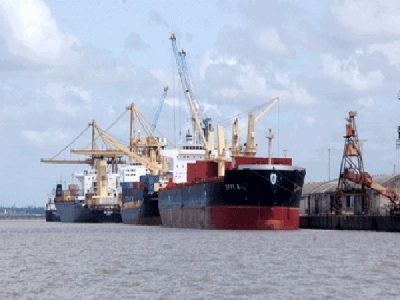
Posted on February 14, 2017
The Maputo Port Development Company (MPDC) on Friday formally announced the conclusion of the dredging of the port access channel, deepening it from 11 to 14.2 metres.
This difference “may not seem much, but it’s those additional three metres which allow us today to state proudly that we are a port which can receive Capesize ships”, the MPDC chief Executive Officer, Osorio Lucas, told the ceremony.
Capesize ships are the largest dry cargo ships, usually transporting coal, mineral ores and other bulk commodities.
The dredging has given the port great competitive advantages, said Lucas. “This week, a ship, the M/V Diavolezza, with a 12.9 metre draft, let the port, without needing to wait for high tide”, he explained. “This meant a gain of 12 hours in transit. That was a record for us”. The Diavolezza is a Swiss bulk carrier, of 87,665 deadweight tonnes, built in January 2016.
The dredging was done by the Luxembourg-based company Jan de Nul. It began in May 2016, and was scheduled to take ten months – but in fact Jan de Nul concluded the work in seven months. Using up to three dredges, the Jan de Mul tems operated in the port access channel for 24 hours a day during the seven months of dredging. Almost 14.5 million cubic metres of sediment and rocky material were removed from the channel.
The total cost was 84.1 million dollars, paid for out of MPDC’s own resources, and from loans from two Mozambican banks.
The dredging is a key part of the MPDC strategy so that Maputo port will be handing 40 million tonnes of cargo a year as from 2020. That means more than doubling traffic through the port. The largest amount of traffic handled by the port to date was 19.1 million tonnes in 2014.
But in 2015, the last year for which full figures have been published, the amount handled dropped by around 20 per cent to 15.6 million tonnes.
Both Lucas and Transport Minister Carlos Mesquita stressed that it is not possible to reach the ambitious target of 40 million tonnes a year relying on road transport.
“Dredging the channel cannot obtain the desired objectives without the due collaboration from the logistics operators”, said Mesquita. “So we urge speed in reforming the rail system so that it can cope with the volumes of cargo that will flow to Maputo port. It is not enough just to transport goods – it must be done efficiently, safely and reliably”.
He wanted to see the Mozambican railways win back the cargo which used to go by rail, but which in recent years has been diverted onto the roads. Mesquita wanted to end “the interminable columns of trucks entering Maputo Port, that inevitably cause congestion and other negative impacts”.
“The rail solution is also fundamental for the Maputo Corridor to maintain its position of prominence in the region”, added the Minister. “There can be no growth that damages our roads and endangers the circulation of people and goods”.
“We can only have sustainable growth if we bank on a balance between road and rail transport, lowering costs throughout the logistical chain”, said Mesquita. “The window of opportunity is open and must be made use of”.
This all meant that Mozambique’s railways had to mobilize the resources and facilities that will be needed to move the huge amounts of goods that the port can handle. “There is an urgent need for a joint business plan, bringing together the efforts of the port and the railways”, added Mesquita.
“In the current conditions of the international market, where each dollar weighs in taking decisions about the various logistical options, we must find partnerships between the various actors in the chain and efficient and competitive logistical solutions”, he stressed.
Everybody involved in the transport chain must be speedy and efficient declared the Minister, and all the costs which contribute to “a heavy final cost” for the port’s clients must be revised. Mesquita included specifically among these costs the charges levied by Kudumba, the company that operates the scanners through which some, but by no means all, port cargo passes. The scanning charges have long been denounced as exorbitant by port users.
All actors in the logistics chain, Mesquita urged, “must work with a single goal – to make the port of Maputo the port of choice for the export of goods from Mozambique, South Africa, Swaziland, Zimbabwe and Botswana. Our country, our economy and our people will gain”.
MPDC is a consortium between Mozambique’s publicly-owned port and rail company, CFM, with 49 per cent of the shares, and Portus Indico with 51 per cent. Portus Indico is owned by DP World of Dubai, Grindrod of South Africa and the Mozambican company Mozambique Gestores.
The Mozambican government leased the port to MPDC in 2003 for 15 years, and in 2009 the lease was extended for a further 15 years expiring in 2033, by which time MPDC should have implemented the entire Master Plan for the port’s development.
Source: Club of Mozambique





